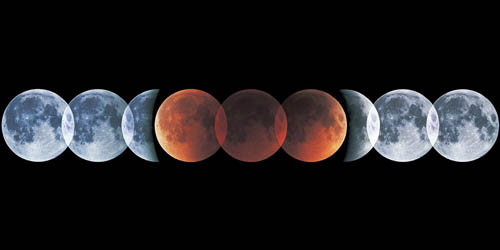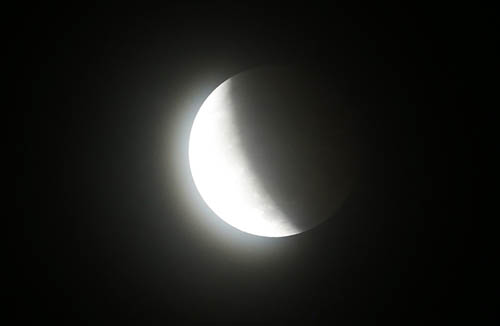The world awaits 'blood moon'
The region of western North America, Asia and some other places will observe the total lunar eclipse, or "blood moon", on April 4.
The first full moon in 2015

The moon passes through the Earth's shadow in the full moon eclipse in 2000. (Photo: Akira Fujii, Sky & Telescope)
"Blood moon" is a rare phenomenon , which occurs only in the full moon phase and when the Moon, Earth and Sun are in equal position. The phenomenon usually occurs twice a year and can only be viewed from one side of the Earth's hemisphere.
During the period of complete obscurity, sunlight shines through the Earth's atmospheric dust ring, which is bent, refracted to the red part of the spectrum and looms over the Moon's surface. Therefore, the Moon disc will go from dark gray in phase one to red yellow in the full phase.
The full phase moon color can vary significantly depending on the amount of dust in the Earth's atmosphere at that time. The active volcano sprayed ash as high as possible to affect the "blood moon ". Before the eclipse, no one could guess the exact color.
Places of observation "moon blood"

The full moon is in Taguig, the metropolitan city of Manila, Philippines, in October last year.(Photo: Reuters)
The total eclipse of April 4 will be the third phenomenon in the group of four lunar eclipses that appear in two years . This kind of phenomenon will not repeat within 20 years or longer. The first two appearances in April and September last year, and the final eclipse will be observed on September 28 this year.
According to scientists, this is the eclipse that the Moon changes in the shortest obscure phase of this century. The most spectacular part is the complete eclipse phase, when the Earth's ball completely covers the Moon and it turns red. The Moon will only travel in the dark areas of the Earth (umbra) and completely obscure for 9-12 minutes.
The western region of North America will see this phenomenon in the sky tomorrow. Meanwhile, the American plain and eastern coastal observer will see the first half when the Moon begins to be covered by Earth's shadow.
People in Asia, India, western China, Russia, Australia and the Pacific have the opportunity to see the second half of the "blood moon" phenomenon . In Vietnam, astronomers can observe the total lunar eclipse in favorable weather conditions. Africa, Europe and the Middle East are on the other half of the Earth, so there will be no eclipse.
Unlike solar eclipses, observers can see the eclipse safely with the naked eye.

The graphic shows the position of the Sun, Earth and Moon when eclipse occurs.(Graphics: Timeanddate)
- Photos: Super blood moon and blue moon all over the world
- NASA rejects the blood moon is a sign of the end of the world
- Chilling the predictions about hyper moon blood appear tonight
- Exotic species of flowers 'thirst' The blood moon is like a wolf
- The image of the blood moon changes color
- Beam photos of beautiful blood moon around the world
- The beautiful 'super moon' around the world
- How did the ancients 'deal' with the blood moon?
- Astronauts have left piles of manure on the Moon and we will have to bring it back
- Hot: Waiting for the phenomenon 'Super blood moon' first appeared for 30 years
- Vietnam in the region of full moon eclipse, blood moon, blue moon most clearly
- The longest lunar eclipse of the century around the world
 Vietnam 5th Asian champion on fuel-efficient vehicles
Vietnam 5th Asian champion on fuel-efficient vehicles We can read all NASA studies completely free of charge
We can read all NASA studies completely free of charge Singer and songwriter Bob Dylan won the 2016 Nobel Prize for Literature
Singer and songwriter Bob Dylan won the 2016 Nobel Prize for Literature Scientific revolution in Asia
Scientific revolution in Asia